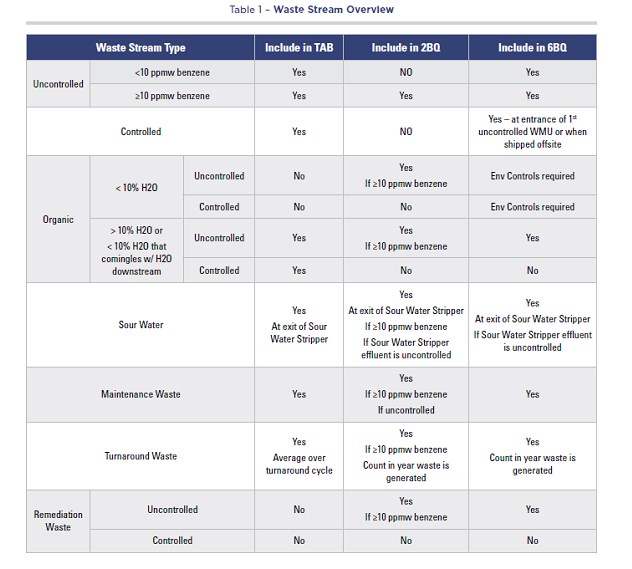The Benzene Waste Operations NESHAP (National Emission Standards for Hazardous Air Pollutants), or more commonly known as BWON, rule was promulgated under 40 CFR Part 61, Subpart FF, of the Clean Air Act in 1993 to control benzene emissions from facility waste.
The rule applies to Petroleum refineries, Chemical plants, Coke by-product recovery facilities and TSDFs (treatment, storage and disposal facilities) that handle Wastes from refineries, chemical plants and coke by production recovery facilities. This complicated rule is unique in that it combines waste and wastewater quality management in an air rule designed to control benzene emissions.
The BWON rule can be broken into several parts: Applicability, Waste & Waste Stream Determination, Compliance options, Points of Waste Generation, and Treatment & Equipment Standards.
The discussion will cover Applicability, Waste & Waste Stream determination, Compliance options, and briefly touch on Points of waste Generation. A future discussion will address Points of waste Generation, and Treatment & Equipment Standards.
Some important BWON definitions are [§61.341]:
Total Annual Benzene (TAB) – “The sum of the annual benzene quantity for each Waste Stream at the facility that has a flow-weighted, volume basis, annual average water content greater than 10 percent or that is mixed with water (or other Wastes), at any time, and the mixture has an annual average water content greater than 10 percent.”
Waste Stream – “The Waste generated by a particular process unit, product tank, or Waste Management Unit. The characteristics of the Waste Stream (e.g., flow rate, benzene concentration, water content) are determined at the Point Of Waste Generation.”
• Examples of a Waste Stream include process wastewater, product tank drawdown, sludge and slop oil removed from Waste Management Units, and landfill leachate.
Waste – “Any material resulting from industrial, commercial, mining or agricultural operations, or from community activities that is discarded or is being accumulated, stored, or physically, chemically, thermally, or biologically treated prior to being discarded, recycled, or discharged.”
• Examples of a Waste include slop oil routed to slop tanks, spent caustics, sludge, DAF float sent offsite, pump drainages, lab wastes, unit wash down material.
Waste Management Unit (WMU) – “A piece of equipment, structure, or transport mechanism used in handling, storage, treatment, or disposal of Waste. “
• Examples of a Waste Management Unit include a tank, surface impoundment, container, oil-water separator, individual drain system, steam stripping unit, thin-film evaporation unit, waste incinerator, and landfill.
Point of waste Generation (POG) – “The location where the Waste Stream exits the process unit component or storage tank prior to handling or treatment in an operation that is not an integral part of the production process, or in the case of Waste Management Units that generate new Wastes after treatment, the location where the Waste Stream exits the Waste Management Unit component.”
Process Wastewater – “Water which comes in contact with benzene during manufacturing or processing operations conducted within a process unit. Process Wastewater is not organic wastes, process fluids, product tank drawdown, cooling tower blowdown, stream trap condensate or landfill leachate.”
The compliance requirements of the BWON rule are determined by the calculated Total Annual Benzene (TAB) quantity for the facility. The annual benzene quantity for a Waste Stream is calculated by multiplying the annual waste quantity of the Waste Stream times the flow-weighted, volume basis, annual average benzene concentration (wt%) of the Waste Stream. [61.355(a)(1)(iii)]
The annual benzene quantity and TAB are calculated in units of Megagrams per year (Mg/yr) of benzene where one Megagram is equal to one metric ton. The benzene quantity for each Waste Stream is determined by estimating the stream annual waste quantity and annual benzene concentration. Periodically the quantity of a waste may not be known. In this situation engineering judgement or operational experience must be used to determine the quantity. The key is to ensure the waste quantity is representative. When determining a Waste quantity, the oil and water fraction of the Waste must be determined.
The BWON rule allows two ways for the determining the benzene concentration for a Waste Stream, process knowledge [§61.355(c)(2)] or direct measurement [§61.355(c)(3)].
As noted in the definition of TAB, the water content of the Waste Stream is a key threshold. Wastes with < 10% water are considered an organic Waste and are not included in the calculation of the TAB. However, if an organic Waste is mixed or co-mingled with an aqueous Waste (a Waste with > 10% water content) then the mixed/co-mingled Waste is treated as an aqueous Waste and the contribution of benzene in the organic phase must be included in the TAB.
Table 1 (above) lists an overview of how various Waste Streams are handled in the TAB and the uncontrolled benzene quantity calculations.
Read Part One in the September issue of Fugitive Emissions Journal, or contact the Editor, Stephanie Matas, at s.matas@kci-world.com.



